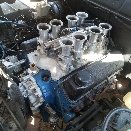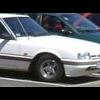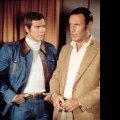-
Content Count
592 -
Joined
-
Last visited
-
Days Won
11
Reputation Activity
-
 Boingk got a reaction from Thom in Boingk's F250 4x4
Boingk got a reaction from Thom in Boingk's F250 4x4
Evening all. I picked this up today. Let me know if the pics don't work.
She's an early dentside F250 4x4, commonly called the 'Highboy' option. She has a 351C and manual trans, lots of rust in the floors and a fairly clean engine compartment.
-

-

-

-
 Boingk reacted to SPArKy_Dave in Decoding your F-truck VIN/Chassis no.
Boingk reacted to SPArKy_Dave in Decoding your F-truck VIN/Chassis no.
The VIN on the engine or car will be 6 characters long, for example, JG63UM or AL1JYM. These are decoded as follows;
First character = Product source.
A = USA, C = UK, J = Australia and S and U = Japan.
Second character = Assembly plant.
G = Broadmeadows - (Passenger), L = Broadmeadows – (Truck), H = Brisbane and K = Sydney
3rd & 4th characters = Body Series
See below
5th & 6th characters = year and month of production respectively
Therefore;
A = USA source
L = Assembled at Broadmeadows Truck plant
1J = F100 4x2
Y = 1981
M = March
F-Series Body Codes
1J = F100 4x2
4K = F100 4x4
1T = F100 Bronco
2J = F250
3J = F350
5K = F350 4x4
4J = F500
6J = F600
1K = F700
2K = F750
3K = F800 and F8000
Now onto the engines. The engine codes for the F series trucks are unique and not linked to the passenger vehicles and are also relevant to the years of manufacture. Therefore, for the following years, the codes apply as follows;
1970
Engine
D = 4.0 litre (240 CID petrol 6 cylinder)
E = 4.9 litre (300 CID petrol 6 cylinder)
T = 5.4 litre (330 CID petrol 8 cylinder)
Transmission
4 = 4 speed
5 = 5 speed
1971
Same as above except for;
Transmission
3 = 3 speed column shift
B = 3 speed floor shift automatic
1972
Same as above
1973
Engine
D = 4.0 litre (240 CID petrol 6 cylinder)
E = 4.9 litre (300 CID petrol 6 cylinder)
Transmission
4 = 4 speed
B = 3 speed floor shift automatic
1974 (US Drive line)
Engine
L = 4.0 litre (240 CID petrol 6 cylinder)
E = 4.9 litre (300 CID petrol 6 cylinder)
Transmission
L = 4 speed manual floor shift
B = 3 speed floor shift automatic
1974 (Local Drive line)
Engine
L = 4.0 litre (250 CID petrol 6 cylinder)
Y = 4.9 litre (302 CID petrol 8 cylinder)
Transmission
L = 4 speed manual floor shift
R = 3 speed automatic
1975
Same as above except for;
Engine
E = 4.9 litre (300 CID petrol 6 cylinder)
1976
Engine
L = 4.0 litre (250 CID petrol 6 cylinder)
Y = 4.9 litre (302 CID petrol 8 cylinder)
E = 4.9 litre (300 CID petrol 6 cylinder)
Transmission
L = 4 speed manual floor shift
R = 3 speed automatic
1977
Same as above except for the 300 CID engine is no longer available
1978
Engine
B = 5.8 litre (Pre-ADR 36)
C = 5.8 litre (Post ADR 36)
Y = 4.9 litre (2 wheel drive only)
X = 4.9 litre (4 wheel drive only)
L = 4.1 litre (Pre-ADR 36)
H = 4.1 litre (Post ADR 36)
Transmission
L = 4 speed manual floor shift
R = 3 speed Cruisomatic column shift
1979 & 1980
Same as above
1981 and onwards
Engine
W = 4.1 litre 6 cylinder
C = 5.8 litre 8 cylinder (carburetor version)
T = 5.0 litre (fuel injected)
Transmission
L = 4 speed manual floor shift
R = 3 speed Cruisomatic column shift
Now back to the model code. I will start with the easy ones first being the 1978 to 1981 F series trucks. As shown above, the ute in question had a model code of 62112 and it is this number that can be used in conjunction with the following code breaker to find out what you have.
Model
Digits 1 & 2 = Product line (more on this later!)
Digit 3 = Year of manufacture (actually applies to all F series trucks)
Digit 4 = Body style
1 – F100 Chassis Cab
2 – F100/250 Style Side Body
3 – F100 Ambulance and F350 Chassis cab
Digit 5 = Series
1 – F100 Short Wheel Base
2 – F100 Long Wheel Base of F250
3 – F350 Short Wheel Base
4 – F350 Long Wheel Base
So from the above model code of 62112, this equates to;
F100 S-Cab, 1981 build year, F100 Chassis Cab, F100 Long Wheel Base of F250.
Now onto the pre 1978 model codes. According to the book, there are heaps of model codes, especially so for the years of 1970 through to 1972 as the codes covered the F100 all the way up to the F700. Therefore, I am only going to cover a year that is more applicable, namely 1976.
62611 – F100A C.Cab 2972 mm W/B 2586 kg GVM
62612 – F100A S.Cab 3379 mm W/B 2586 kg GVM
62621 – F100A S.Box 2972 mm W/B 2586 kg GVM
62622 – F100A S.Box 3379 mm W/B 2586 kg GVM
62632 – F100A Ambulance 3379 mm W/B 2717 kg GVM
74611 – F250A 2WD C.Cab 3379 mm W/B 3448 kg GVM
74612 – F250A 2WD S.Box 3379 mm W/B 3448 kg GVM
73613 – F250A 4WD C.Cab 3379 mm W/B 3493 kg GVM
73614 – F250A 4WD S.Box 3379 mm W/B 3493 kg GVM
74631 – F350A C.Cab 3480 mm W/B 4536 kg GVM
74632 – F350A C.Cab 4089 mm W/B 4536 kg GVM
As you can see, the two first numbers (Product Line) change according to the type of vehicle required. (info, courtesy of 'Paull', from Ford Australia Forums) -
 Boingk got a reaction from Thom in Boingk's F250 4x4
Boingk got a reaction from Thom in Boingk's F250 4x4
Evening all. I picked this up today. Let me know if the pics don't work.
She's an early dentside F250 4x4, commonly called the 'Highboy' option. She has a 351C and manual trans, lots of rust in the floors and a fairly clean engine compartment.
-
 Boingk got a reaction from Thom in Boingk's F250 4x4
Boingk got a reaction from Thom in Boingk's F250 4x4
Evening all. I picked this up today. Let me know if the pics don't work.
She's an early dentside F250 4x4, commonly called the 'Highboy' option. She has a 351C and manual trans, lots of rust in the floors and a fairly clean engine compartment.
-
 Boingk got a reaction from deankxf in CLEVELAND ENGINE TALK
Boingk got a reaction from deankxf in CLEVELAND ENGINE TALK
I'll be on the Clevo bandwagon again, my XF is off to the scrappers and the engine has a new home in a bloke's speedboat. Here's to lockdown projects!
-
 Boingk got a reaction from CHESTNUTXE in WINDSOR SMALLBLOCK TALK
Boingk got a reaction from CHESTNUTXE in WINDSOR SMALLBLOCK TALK
Just make a nice streetable 302.
http://www.mustangandfords.com/how-to/engine/28898-400-hp-302-small-block/
-
 Boingk got a reaction from deankxf in CLEVELAND ENGINE TALK
Boingk got a reaction from deankxf in CLEVELAND ENGINE TALK
I'll be on the Clevo bandwagon again, my XF is off to the scrappers and the engine has a new home in a bloke's speedboat. Here's to lockdown projects!
-
 Boingk got a reaction from CHESTNUTXE in WINDSOR SMALLBLOCK TALK
Boingk got a reaction from CHESTNUTXE in WINDSOR SMALLBLOCK TALK
Just make a nice streetable 302.
http://www.mustangandfords.com/how-to/engine/28898-400-hp-302-small-block/
-

-
 Boingk reacted to gerg in CLEVELAND ENGINE TALK
Boingk reacted to gerg in CLEVELAND ENGINE TALK
"Still worth repairing" is a very subjective statement. In the hands of someone who is on to it and can diagnose and do the work themselves, it may well be worth it, but if he needs to go to a mechanic every time something else fails, then maybe a 40-odd year old truck is not for him.
Choofing fumes out the breather is not a good sign, it will definitely lose compression at lower rpm where it is most needed in a truck.
The block could well be a basket case if it's worn out and already gone +30 on the bore. If it's only broken a ring or scored one or two bores, it might be worth sleeving, but 383s are pretty poor for rod/stroke ratio. 1.52 is definitely in the lower end of an ideal ratio. It might just be a worn piston so he could be lucky there (if you can call an engine overhaul "lucky") and not have worn the bore(s)
Really, if it's been on LPG the whole time, you would expect bore or piston wear to be the least of your problems. Being a dry fuel, there is no oil dilution, just pure oil on all parts. There is the issue of acid buildup in the oil over time, but that mainly causes bearing erosion.
The fact that it's been through several owners is a problem too, you don't know how much it might have been neglected or thrashed.
Sent from my CPH1903 using Tapatalk
-
 Boingk got a reaction from Thom in 302 Cleveland to 351 convertion
Boingk got a reaction from Thom in 302 Cleveland to 351 convertion
Yeah mate it was all pretty standard stuff. I didn't open the block up at all as it ran well and kept good oil pressure - I just replaced the camshaft, timing set, lifters and intake. Standard pushrods, new hydraulic HT900 lifters from Elgin.
I'd recommend new springs and retainers for your valves, but honestly mine was fine with the stock stuff. Mind you it wasn't being used hard, just the occasioanl hard run when getting onto the open road. It's still on the road, too, so can't have been too much trouble for the new owner.
-
 Boingk got a reaction from Gmskippy in 302 Cleveland to 351 convertion
Boingk got a reaction from Gmskippy in 302 Cleveland to 351 convertion
Here's my closed chamber 351C with the Elgin E-907-P:
The heads are definitely worth a quick go-over, even just to take of casting flash and smooth harsh transitions. This will give a nice bump throughout the range. For the cost of a $30 carbide bit from the local hardware store and a bit of elbow grease its well worth it. I wouldn't pay someone to do it as you're better off putting money towards aftermarket heads IMO.
-
 Boingk got a reaction from Thom in 302 Cleveland to 351 convertion
Boingk got a reaction from Thom in 302 Cleveland to 351 convertion
Yeah mate it was all pretty standard stuff. I didn't open the block up at all as it ran well and kept good oil pressure - I just replaced the camshaft, timing set, lifters and intake. Standard pushrods, new hydraulic HT900 lifters from Elgin.
I'd recommend new springs and retainers for your valves, but honestly mine was fine with the stock stuff. Mind you it wasn't being used hard, just the occasioanl hard run when getting onto the open road. It's still on the road, too, so can't have been too much trouble for the new owner.
-
 Boingk reacted to gerg in 302 Cleveland to 351 convertion
Boingk reacted to gerg in 302 Cleveland to 351 convertion
If your 302 hasn't been messed with, the heads will be closed chamber. The only Clevos that were closed were early 4Vs and Aussie 302 2Vs (with smaller chambers again).
Closed chamber is a superior design for the way it promotes combustion. It creates turbulence just as the piston teaches TDC and promotes more complete combustion, it also keeps the burning mixture moving, to keep chamber temps more even and prevent hotspots (thus detonation).
Sent from my CPH1903 using Tapatalk
-
 Boingk reacted to Gmskippy in 302 Cleveland to 351 convertion
Boingk reacted to Gmskippy in 302 Cleveland to 351 convertion
Thanks Boingk, I dont know if these heads are close chambered or not how do I know what I am looking at? What lifters did you go with? Was averything else standard kit?
Thanks.
-
 Boingk got a reaction from Thom in 302 Cleveland to 351 convertion
Boingk got a reaction from Thom in 302 Cleveland to 351 convertion
HI mate, I made a 351 with 302C heads, 4bbl intake and a Holley 600 I put a kit through. Went like bejesus, I used an Elgin E-907-P camshaft and it was lovely - good and torquey still down low with a nice rorty idle, then went pretty hard through the midrange when you put your foot down. Compression was about 10.7 to 1 but 95 octane was fine with total timing about 30 degrees and an idle timing of 15.
-
 Boingk got a reaction from Thom in 302 Cleveland to 351 convertion
Boingk got a reaction from Thom in 302 Cleveland to 351 convertion
HI mate, I made a 351 with 302C heads, 4bbl intake and a Holley 600 I put a kit through. Went like bejesus, I used an Elgin E-907-P camshaft and it was lovely - good and torquey still down low with a nice rorty idle, then went pretty hard through the midrange when you put your foot down. Compression was about 10.7 to 1 but 95 octane was fine with total timing about 30 degrees and an idle timing of 15.
-
 Boingk got a reaction from Thom in 302 Cleveland to 351 convertion
Boingk got a reaction from Thom in 302 Cleveland to 351 convertion
HI mate, I made a 351 with 302C heads, 4bbl intake and a Holley 600 I put a kit through. Went like bejesus, I used an Elgin E-907-P camshaft and it was lovely - good and torquey still down low with a nice rorty idle, then went pretty hard through the midrange when you put your foot down. Compression was about 10.7 to 1 but 95 octane was fine with total timing about 30 degrees and an idle timing of 15.
-
 Boingk reacted to gerg in 302 Cleveland to 351 convertion
Boingk reacted to gerg in 302 Cleveland to 351 convertion
Or crank and rods from a 351, standard pistons. Everything else is identical. But you will end up with high compression, so make sure you have a decent cam to compensate.
Sent from my CPH1903 using Tapatalk
-
 Boingk reacted to CHESTNUTXE in CLEVELAND ENGINE TALK
Boingk reacted to CHESTNUTXE in CLEVELAND ENGINE TALK
New rocker covers came now change paint to black on bolts instead of blue
Sent from my SM-G570Y using Tapatalk
-
 Boingk reacted to CHESTNUTXE in CLEVELAND ENGINE TALK
Boingk reacted to CHESTNUTXE in CLEVELAND ENGINE TALK
this is another 400 i got and cheap rebuild for sale soon
-
 Boingk got a reaction from CHESTNUTXE in CLEVELAND ENGINE TALK
Boingk got a reaction from CHESTNUTXE in CLEVELAND ENGINE TALK
Wait, which intake are you using, the Weiand job or the stocker?






